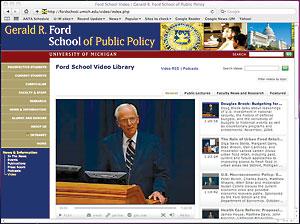|
Browse the video library at the Gerald R. Ford School of Public Policy > |
When former U.S. Sen. Chuck Hagel spoke at U-M last month, he generated a bit of news with a brief passage in which he called some of his ex-colleagues irresponsible for trying to block health care reform as a way to injure the Obama presidency.

The comments weren’t picked up immediately, but a couple weeks later — on Friday, Oct. 23 — they appeared in The Hill, an online publication that follows congressional politics, along with a link to a video of Hagel’s speech that is available through the Ford School of Public Policy’s new online video library.
That same day, numerous other blogs — large and small — jumped on the story, pointing readers to The Hill and the Ford School video, in some cases embedding it on their own sites. During the next four days about 180,000 viewers saw the video link on one site or another, and some 1,800 clicked through to watch the 85-minute speech, says Chris Myers, who designed the video library.
For those involved with the new video project, that weekend’s flurry of activity illustrates its potential, not only as a repository of lectures and speeches, but also as a marketing tool for the Ford School.
“These (videos) provide little windows into the Ford School and all the great work we do,” says Laura K. Lee, director of communications and outreach. “The idea is it can contribute to the dialogue across the spectrum (of public opinion).”
The new video library has been available for more than a month, following a September testing and refinement period. Going forward, videos of new speeches at the school and its research centers will be uploaded within days of when they are given, Myers says.
Currently the site contains 87 entries going back to 2003. They range from recent lectures by such speakers as Hagel and economist Paul Krugman to interviews with the late President Gerald Ford as well as his U-M memorial service.
The library is a 15-month pilot project with Brightcove, a Boston-based online video platform used by many businesses and online media companies. Myers and Lee say the new, Flash-based library has many advantages over the previous system, which required viewers to download the videos and view them in a standalone viewing application.
Similar to what Web viewers have grown accustomed to from sites such as YouTube, the new system offers faster access with greater quality and the ability for visitors to easily embed code in their own blogs or Web pages. Embedding them makes the videos available to an even broader range of viewers. People also can subscribe to video RSS feeds to access new lectures as they become available.
“We want our public lectures to have a shelf life for people beyond those who are able to attend them in person,” Lee says. The new system is “much more conducive to being shared, and therefore more conducive to being picked up by more people.”
When someone embeds a Ford School video in another Web page, it links to the full speech, not just an isolated segment, and the window that presents the video carries the Ford School branding, which helps promote the school and build its reputation among prospective students and the public policy community centered on the East Coast.
The new system also allows the Ford School customized presentation and organization, filtering, searchability and more detailed viewership statistics.

